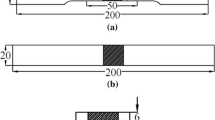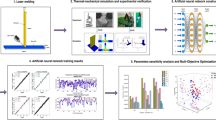Abstract
Weld quality is a critical issue in fabrication industries where products are custom-designed. Multi-objective optimization results number of solutions in the pareto-optimal front. Mathematical regression model based optimization methods are often found to be inadequate for highly non-linear arc welding processes. Thus, various global evolutionary approaches like artificial neural network, genetic algorithm (GA) have been developed. The present work attempts with elitist non-dominated sorting GA (NSGA-II) for optimization of pulsed gas metal arc welding process using back propagation neural network (BPNN) based weld quality feature models. The primary objective to maintain butt joint weld quality is the maximization of tensile strength with minimum plate distortion. BPNN has been used to compute the fitness of each solution after adequate training, whereas NSGA-II algorithm generates the optimum solutions for two conflicting objectives. Welding experiments have been conducted on low carbon steel using response surface methodology. The pareto-optimal front with three ranked solutions after 20th generations was considered as the best without further improvement. The joint strength as well as transverse shrinkage was found to be drastically improved over the design of experimental results as per validated pareto-optimal solutions obtained.





Similar content being viewed by others
References
M. Thamodharan, H.P. Beck, A. Wolf, Steady and pulsed direct current welding with a single converter. Weld. J. 78(3), 75s–79s (1999)
P.K. Ghosh et al., Arc characteristics and behaviour of metal transfer in pulsed current GMA welding of aluminium alloy. J. Mater. Process. Technol. 194(1–3), 163–175 (2007)
Y.S. Kim, Metal transfer in gas metal arc welding, PhD Thesis MIT, Cambridge, 1989
P. K. Palani, N. Murugan, Selection of parameters of pulsed current gas metal arc welding. J. Mater. Process. Technol. 172(1), 1–10 (2006)
K.Y. Benyounis, A.G. Olabi, Optimization of different welding processes using statistical and numerical approaches—a reference guide. Adv. Eng. Softw. 39, 483–496 (2008)
D. Kim, S. Rhee, Optimization of a gas metal arc welding process using the desirability function and the genetic algorithm. IMechE Proc. Instrum. Mech. Eng. Part B J. Eng. Manuf. 218, 35–41 (2004)
D. Kim, S. Rhee, Design of a robust fuzzy controller for the arc stability of CO2 welding process using the Taguchi method. IEEE Trans. Syst. Man Cybern. Part B Cybern. 32(2), 157–162 (2002)
A.G. Olabi et al., An ANN and Taguchi algorithms integrated approach to the optimization of CO2 laser welding. Adv. Eng. Softw. 37, 643–648 (2006)
Y.A. Song, S. Park, S.W. Chae, 3D welding and milling: part II—optimization of the 3D welding process using an experimental design approach. Int. J. Mach. Tools Manuf. 45, 1063–1069 (2005)
V. Balasubramanian et al., Application of response surface methodology to prediction of dilution in plasma transferred arc hardfacing of stainless steel on carbon steel. Int. J. Iron Steel Res. 16(1), 44–53 (2009)
D.S. Correia, C.V. Gonçalves, S.S. da Cunha, V.A. Ferraresi Jr., Comparison between genetic algorithms and response surface methodology in GMAW welding optimization. J. Mater. Proc. Technol. 160, 70–76 (2005)
Y.W. Huang, P.C. Tung, C.Y. Wu, Tuning PID control of an automatic arc welding system using a SMAW process. Int. J. Adv. Manuf. Technol. 34, 56–61 (2007)
D.S. Correia et al., GMAW welding optimization using genetic algorithms. J. Braz. Soc. Mech. Sci. Eng. 16(1), 28–33 (2004)
D. Kim, M. Kang, S. Rhee, Determination of optimal welding conditions with a controlled random search procedure. Weld. J. 84, 125s–130s (2005)
T.K. Meng, C. Buffer, Solving multiple response optimisation problems using adaptive neural networks. Int. J. Adv. Manuf. Technol. 13, 666–675 (1997)
Y.W. Park, S. Rhee, Process modeling and parameter optimization using neural network and genetic algorithms for aluminum laser welding automation. Int. J. Adv. Manuf. Technol. 37, 1014–1021 (2008)
K. Deb, Multi-objective Optimization Using Evolutionary Algorithms (Wiley, New York, 2001)
K. Deb, A. Pratap, S. Agarwal, T. Meyarivan, A fast and elitist multiobjective genetic algorithm: NSGA-II. IEEE Trans. Evol. Comput. 6(2), 182–197 (2002)
C. Senthilkumar, G. Ganesan, R. Karthikeyan, Parametric optimization of electrochemical machining of Al/15% SiCp composites using NSGA-II. Trans. Nonferrous Metals Soc. China 21(10), 2294–2300 (2011)
Du Zhijiang, Yang Wenlong, Dong Wei, Kinematics modeling and performance optimization of a kinematic-mechanics coupled continuum manipulator. Mechatronics 31, 196–204 (2015)
P. Saha, D. Tarafdar, S.K. Pal, P. Saha, A.K. Srivastava, K. Das, Multi-objective optimization in wire-electro-discharge machining of TiC reinforced composite through Neuro-Genetic technique. Appl. Soft Comput. 13(4), 2065–2074 (2013)
K. Pal, S. Bhattacharya, S.K. Pal, Multisensor-based monitoring of weld deposition and plate distortion for various torch angles in pulsed MIG welding. Int. J. Adv. Manuf. Technol. 50(5–8), 543–556 (2010)
K. Pal, S.K. Pal, Study of weld joint strength using sensor signals for various torch angles in pulsed MIG welding. CIRP J. Manuf. Sci. Technol. 3(1), 55–65 (2010)
Y. LeCun, Efficient learning and second-order methods, A tutorial at NIPS 93, Denver, 1993
Acknowledgements
The authors are immensely grateful to Steel Technology Centre, IIT Kharagpur for the work material, carrying out the sample preparation and measurement of weld joint quality characteristics. They also wish to acknowledge the assistance and support provided by the Welding Laboratory of the Department of Mechanical Engineering, IIT Kharagpur.
Author information
Authors and Affiliations
Corresponding author
Rights and permissions
About this article
Cite this article
Pal, K., Pal, S.K. Multi-objective Optimization of Pulsed Gas Metal Arc Welding Process Using Neuro NSGA-II. J. Inst. Eng. India Ser. C 100, 501–510 (2019). https://doi.org/10.1007/s40032-018-0466-2
Received:
Accepted:
Published:
Issue Date:
DOI: https://doi.org/10.1007/s40032-018-0466-2




